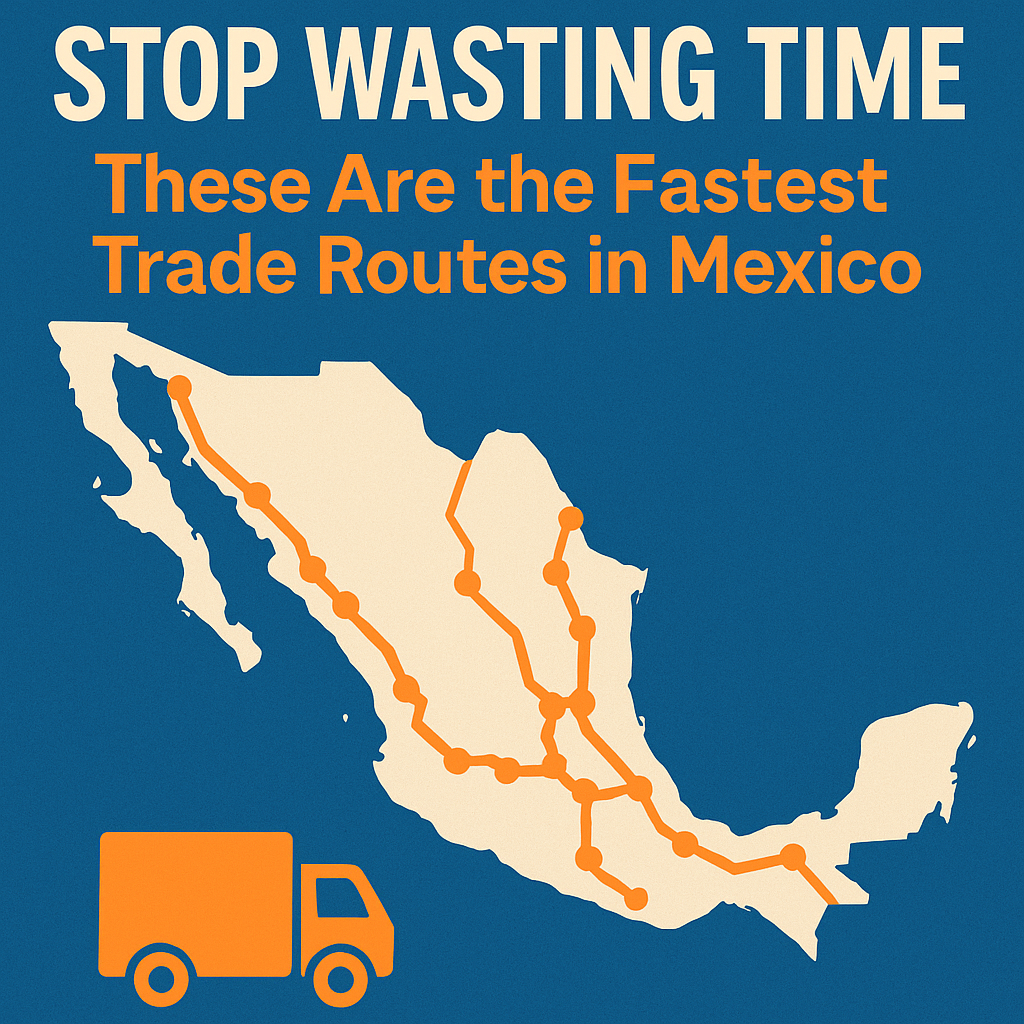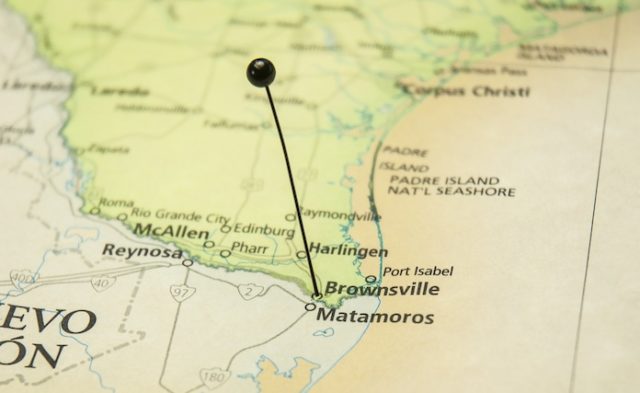Last Updated on June 12, 2025

If you’re thinking about manufacturing in Mexico—or already shipping freight across the country—there’s one thing you can’t afford to overlook: speed. More specifically, the speed of your supply chain. And where does that speed live? In the trade routes of Mexico. Whether you're moving goods from a maquiladora in Matamoros or shipping components through Lázaro Cárdenas, the path your cargo takes matters. A lot.
Some routes in Mexico are smooth, efficient, and practically made for logistics. Others? Let’s just say your trucks might still be stuck there by next Tuesday. So, how do you know which ones to trust? Let’s break down the fastest trade routes in Mexico—and why shaving hours off your transit time is worth every peso.
Why Trade Routes in Mexico Aren’t All Built the Same
Sure, on a map, highways look pretty straightforward. But if you’ve done business in Mexico, you know: not all roads are created equal. Some are plagued by bottlenecks or potholes, or unexpected problems. Others? They flow like a dream.
Here’s the thing—Mexico’s geography plays a huge role. It’s a long, skinny country flanked by two oceans, peppered with mountain ranges, and stitched together by corridors of industrial activity. And the fastest trade routes tend to hug the regions where manufacturing and logistics already thrive.
So, what are the hot routes? Let’s take a look.
Route 1: The Northern Powerhouse — Monterrey to Laredo
If you only remember one route, make it this one.
Why it matters: Monterrey is Mexico’s industrial nerve center. Laredo, Texas? It’s the #1 inland port in the U.S.
This corridor sees millions of crossings every year. It’s well-paved, well-patrolled, and packed with customs brokers and logistics firms who know the game. The Nuevo Laredo–Laredo border crossing is basically the I-95 of nearshoring.
The Port of Laredo is the number 1 port in the nation among more than 450 airports, seaports, and border crossings with $339 billion in total trade with the world in 2024 according to the U.S. Census Bureau data analyzed by WorldCity. - Laredo DEC
Bonus: Nuevo León has invested heavily in security and highway maintenance, which helps trucks move with fewer delays. You can practically set your watch to it.
Route 2: The Hidden Gem — Matamoros to Brownsville and Up Through Texas
It doesn’t always get the spotlight like Laredo, but the Matamoros–Brownsville trade corridor is a quiet workhorse—especially for companies with operations in Northeast Mexico, such as NovaLink. If you’re near the Gulf, this route can cut serious time and complexity out of your logistics plan.
Here’s the angle: Matamoros is home to dozens of maquiladoras, with a strong presence in textiles, electronics, automotive components, and medical devices. Brownsville, Texas? It’s rapidly scaling up as a logistics hub, offering rail, port, and highway infrastructure without the congestion you’ll find in bigger crossings.

Where Are Brownsville and Matamoros?
Brownsville, TX is located on the far-south border of Texas, and Matamoros, Tamaulipas, Mexico, is located just across the Mexican border, on the southern bank of the Rio Grande.
In Tamaulipas, the manufacturing industry is primary to the economy's health. Tamaulipas ranks fifth among the states with the fastest growth along Mexico's northern border.
Once your goods are through Brownsville, Interstate 69E and 77 give you a straight shot north—through Corpus Christi, Houston, and beyond. That means less traffic, fewer delays, and more predictability than some of the western crossings.
Why it’s underrated:
- Shorter border wait times than Laredo or El Paso
- Strategic location for Gulf Coast access and eastbound shipping
- Excellent for time-sensitive goods, especially textiles and electronics
Good to know: The Port of Brownsville is expanding too, making this route even more attractive for companies that want both land and sea access within the same corridor.
Bottom line? If you’re manufacturing in Tamaulipas or the eastern maquiladora belt, the Matamoros–Brownsville trade route is a strategic shortcut that can save time without sacrificing reliability. It’s not flashy—but it’s fast.
How Far Away is Brownsville?
Refer to the list below to determine how far away Brownsville is from most major U.S. cities.
City
Albuquerque
Atlanta
Boston
Chicago
Dallas
Denver
Detroit
Houston
Kansas City
Las Vegas
Los Angeles
Minneapolis
New York
Oklahoma City
Phoenix
San Diego
Seattle
St. Louis
Distance
992 mi
1,145 mi
2,196 mi
1,489 mi
559 mi
1,218 mi
1,744 mi
353 mi
1,101 mi
1,557 mi
1,632 mi
1,537 mi
1,982 mi
755 mi
1,259 mi
1,606 mi
2,436 mi
1,193 mi
Route 3: The Bajío Triangle — Querétaro to El Bajío to León
Think of this region as Mexico’s automotive and aerospace gold mine. It’s home to some of the country’s biggest manufacturing plants and Tier 1 suppliers.
Why it works: This route connects Querétaro (home of Bombardier and GE) through Celaya and Irapuato, ending in León, a major leather and export hub. It’s central, it’s efficient, and it links directly to Highway 57 and Highway 45D—Mexico’s trade superhighways.
The hidden advantage: Trains. Ferromex and Kansas City Southern offer intermodal services here, cutting costs and transit times.
Route 4: West Coast Flow — Guadalajara to Manzanillo Port
This one’s for companies shipping to Asia—or importing from it.
What makes it fast: The Guadalajara-Manzanillo corridor is a direct shot from one of Mexico’s biggest cities to one of its most important ports. And Manzanillo? It’s the busiest container port in the country.
This route is especially valuable for high-tech and electronics manufacturing in Jalisco, as it avoids the northern border altogether and keeps everything Pacific-facing.
Watch out for: Weather delays during hurricane season—but hey, nothing’s perfect.
Route 5: East Coast Link — Puebla to Veracruz
Puebla is booming in the automotive world, and Veracruz is the port that feeds it.
Why it matters: This is a critical corridor for finished vehicles and auto parts heading to Europe and the U.S. East Coast.
The Federal Highway 150D connects them efficiently, with dedicated infrastructure for automotive freight.
Pro tip: Use it when you want to avoid congestion at Altamira or Lázaro Cárdenas—and when you’ve got goods that need to sail east.
Route 6: Cross-Border Ace — Tijuana to San Diego
Short. Sweet. Strategic.
The play here: Tijuana is a massive medical device and electronics manufacturing hub. San Diego is, well, San Diego. The Otay Mesa and San Ysidro crossings are among the busiest—and fastest—on the border.
Why it wins: You can literally ship goods in the morning and have them delivered in Southern California before lunch. That’s a huge advantage in time-sensitive industries.
Just keep in mind: Border wait times can fluctuate, so good customs planning is key.
Why Speed Isn’t Just About the Clock
Let’s be real—saving two hours on a freight route sounds nice, but is it worth re-routing your entire operation?
Actually, yeah. Because time isn’t just a number. It’s inventory sitting on a truck. It’s a customer waiting for parts. It’s cash flow, compliance, and credibility all wrapped into one.
And let’s not forget: U.S. companies manufacturing in Mexico already enjoy lower labor costs and shorter lead times than overseas options. But pair that with faster trade routes? Now you’re stacking the deck.
What Slows Things Down—And How to Avoid It
Even the best routes have pitfalls. Here’s what can throw a wrench in your timeline:
- Customs delays at border crossings
- Security checkpoints that... take their time
- Poor last-mile infrastructure in rural zones
The fix? Partner with logistics providers who know the terrain, and keep real-time visibility tools in your pocket. Waze and WhatsApp groups may seem low-tech, but they’re often faster than any fancy TMS.
Wrapping It Up: Choose Smart, Ship Faster
When it comes to trade routes in Mexico, the shortest path isn’t always the fastest—and the fastest path isn’t always obvious. But once you know the corridors that actually work, you can save more than just time. You save money, headaches, and missed opportunities.
So don’t just pick a route. Pick a lane that moves your business forward.
FAQs on Trade Routes in Mexico
What are the most reliable trade routes in Mexico for U.S.-bound shipments?
The Monterrey to Laredo corridor and the Tijuana to San Diego route are widely considered the most reliable, thanks to strong infrastructure and frequent crossings.
Which Mexican port is best for shipping to Asia?
Manzanillo Port on the Pacific Coast is the top choice due to its container capacity and connectivity with Guadalajara’s manufacturing base.
Are rail options available on Mexico’s trade routes?
Yes—especially in the Bajío region. Ferromex and KCSM (now part of CPKC) offer intermodal rail services that support cross-border efficiency.
How do I reduce delays at Mexican border crossings?
Work with experienced customs brokers, use CTPAT-certified carriers, and monitor peak crossing hours to avoid congestion.
Is it safe to ship through interior trade routes in Mexico?
Generally, yes—especially along major corridors. Routes like Monterrey–Laredo and Puebla–Veracruz are patrolled and maintained. But stay updated on local news and road conditions for any disruptions.
About NovaLink
As a manufacturer in Mexico, NovaLink employs a unique approach that transcends the traditional model of shelter production. More than just the location of your manufacturing, we would like to become a partner in your manufacturing in Mexico. You will be able to relocate or initiate manufacturing for your company in Mexico in a low-cost labor environment with very little delay or up-front costs. Find out how we can help you by handling the manufacturing process.
There are NovaLink facilities in the border cities of Brownsville, Texas, Matamoros, Mexico, and Saltillo, Mexico.